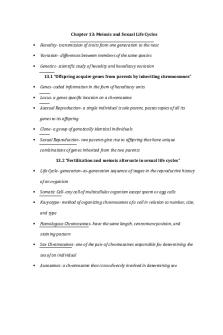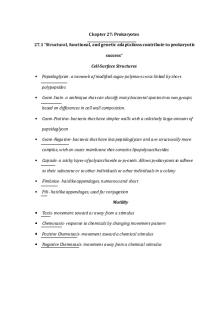Campbell Biology 11th edition chapter 29 summary PDF

| Title | Campbell Biology 11th edition chapter 29 summary |
|---|---|
| Author | Laura Ramos |
| Course | Biology Science Maj II (lec + Lab) HNS |
| Institution | Tarrant County College |
| Pages | 6 |
| File Size | 64.1 KB |
| File Type | |
| Total Downloads | 52 |
| Total Views | 177 |
Summary
This is a chapter summary ...
Description
Laura Ramos BIOL 1407 Professor Byrd Plant Diversity I: How Plants Colonized Land
The origin of terrestrial plants is an extensive and still studied topic. The thousands of known species are only part of what has existed, because during the course of life on the planet new species have been produced, others have become extinct and are probably unknown, a primitive algae managed to survive in the terrestrial environment, before becoming the first plant in the world that inhabited and colonized our planet.
During the first years of Earth's history, the continents of our planet would have been devoid of all life except for microbes. All this changed thanks to the origin of land plants, dyeing the continents green and creating habitats that animals would later invade leaving the sea. And we believed that this moment had occurred around 420 million years ago. The most accepted theory is that land plants evolved from green algae 510-630 million years ago. Before, some organisms already carried out a process of photosynthesis; cyanobacteria and other types of bacteria formed some of the first photosynthetic beings and towards the Paleoproterozoic era, 2,500-1,600 million years ago, cyanobacteria or blue-green algae, of prokaryotic cells, already generated oxygen molecules through photosynthesis. It is possible that the first eukaryotic cells of green plants evolved from prokaryotes (bacteria). The so-called "endosymbiotic theory" or symbiogenesis proposes that the bacteria that performed photosynthesis were consumed by endocytosis by eukaryotic cells and in this way the first plant cells originated. The truth is that the fossils of the oldest eukaryotic cells bear much resemblance to green algae. With photosynthesis, the level of oxygen in the atmosphere gradually rose and as a result, the ozone layer formed and conditions for the existence of more complex life forms increased.
An adaptation can be structural, associated with a physical part of the organism, or it can be behavioral because it affects the way an organism acts. Plants called succulents have adapted to this climate by storing water in their thick stems and leaves. Animal migration is an example of behavioral adaptation.
Laura Ramos BIOL 1407 Professor Byrd Some adaptations are called exaptations. An exaptation is an adaptation developed for one purpose but used for another. Sometimes an organism develops an adaptation or set of adaptations that create a completely new species. This process is known as speciation. Physical isolation or specialization of a species can also lead to speciation. When organisms adapt to other organisms we are in the presence of co-adaptation.
Functional traits are those morphological, physiological or phenological attributes of the organisms that determine their biological efficacy and, therefore, their success under certain environmental conditions. For example, in plants, having leaves capable of not wilting when water is scarce can be an advantage since this characteristic helps them avoid drying out certain organs and maintaining photosynthetic activity under these conditions (that is, continuing to grow). However, these types of sheets are generally more "expensive" to build, to acquire these properties it is necessary to invest a greater amount of resources. This makes these types of sheets less "profitable" in those places where water availability is not an important limitation, and under these conditions, it is more profitable to invest in a greater number of "cheap" sheets (without the need to acquire such properties ).
Knowing the life cycle of plants, or also called the life cycle or biological cycle of plants, is very useful for agricultural and gardening practices since it allows you to take full advantage of the stages of different types of plants, contributing to favor its growth and development and even its reproduction. It is also something basic about plant biology that should be learned and studied in schools.
The life cycle of plants consists of the different phases and stages through which the plant passes throughout its life. This cycle varies depending on the species in question and its mode of reproduction. Thus, there are different types of plants that reproduce differently; specifically, by sexual reproduction or asexual reproduction.
Laura Ramos BIOL 1407 Professor Byrd Sexual reproduction: most plants reproduce sexually. It is characterized by the existence of differentiated sexes, so that, when the sperm comes into contact with the ovum of the plant, a seed will be formed that will give rise to a new plant. Asexual reproduction: this mode of reproduction is much simpler than the previous one since the plant can reproduce itself, being able to divide and give rise to a new one. The life cycle of plants with sexual reproduction - how they grow to depend on the following:
1. Seed 2. Germination 3. Growth 4. Reproduction or pollination
Flowers are the reproductive structures of angiosperm plants, whose species represent almost 90% of all current terrestrial plants. On them depends, directly or indirectly, most of life. However, flowers are a recent evolutionary innovation in the geological calendar of plant diversification.
The bryophytes (broadly, including mosses, liverworts) have been systematically ignored throughout the history of man, mainly due to their small size and the relative difficulty of determining species. However, these small plants offer a multitude of utilities for the human being, whether direct or indirect. NON-VASCULAR PLANTS
Non-vascular plants lack internal tubes or vessels that carry water and minerals or nutrients throughout the plant. Most of them are in humid or submerged places since this type of environment allows them to absorb water through the surface of their tissues. In non-vascular plants, the absence of authentic leaves, stems, and roots are due to the lack of a vascular system.
Laura Ramos BIOL 1407 Professor Byrd Within non-vascular plants, we can find many types of algae (aquatic) and bryophytes (terrestrial).
NON-VASCULAR PLANTS (BRIOFITAS)
Among the bryophytes are mosses and liverworts. They live in humid places, on the ground of the rainforests, where they form a thick green carpet. Also, they are born on the rocks and the humid trunks of the trees are very important for being the precursor species in the colonization of vegetables of the rocks and the ground. Although these plants can cover an area of several kilometers, such as a carpet, their height does not usually exceed 3 cm. high due to the difficulty of not having developed conductive vessels. The ones that have reached the highest height only measure 20 cm. This group of plants exists more than 280 million years ago. Without conductive vessels (Hepatic) with primitive conductive vessels (Mosses)
VASCULAR PLANTS They are also called cormophytes plants and they are the plants that contain true roots, stem, and leaves. The root, in addition to holding the plant, sucks nutrients from the soil or serves as a food reserve. The stem allows the leaves, flowers, and fruits to be separated from the soil, which allows greater growth of these vegetables concerning bryophytes. Vascular plants have conductive vessels (vascular system), where water; nutrients or different minerals circulate, inside the plant. There are two types of conductive vessels: Xylem and Phloem. Xylem: Conducts water and nutrients from the roots to the rest of the plant. Phloem: Conducts synthesized nutrients from the leaves to the rest of the plant.
VASCULAR PLANTS WITHOUT SEEDS (PTERIDOFITAS)
Ferns are an example of vascular plants that do not produce seed. They are called pteridophytes. From the evolutionary point of view, they are very simple plants, because they do not have the complex reproductive structures that allow seeds to be generated. Ferns can be found in
Laura Ramos BIOL 1407 Professor Byrd wetlands, forests, open countryside, hillsides, over trees, buildings, and houses. High humidity is essential because their reproductive systems need it. Fern leaves are called fronds. These facilitate the identification of the different types of ferns. There are ferns with underground stems, which mean that their growth occurs underground. In contrast, tree ferns have aerial stems. The growth of aerial stems occurs above ground.
VASCULAR PLANTS WITH SEEDS (Spermatophytes).
Many of the vascular plants produce seeds. When the seeds fall in the ground and the conditions are favorable, they germinate and form new plants of the same species. Seedlings adapt to survive in different environments. In very dry places, the seeds have the ability to remain dormant until it rains, to germinate. In very humid places, the seed has mechanisms to avoid rotting before germinating. Seeds have different ways of dispersing. To ensure dispersion, some use the wind, some use water and others do so through animals. Scientists group plants with seeds into two groups: gymnosperms and angiosperms. This division facilitates the study, identification, and classification of plants: gymnosperms and angiosperms. Seed formed in open receptacle (Gymnosperms) Seed formed in closed receptacle (Angiosperms)
Phloem and xylem are vascular tissues of tracheophyte plants, that is, vessel-carrying plants that transport sap in plant organisms: pteridophytes, gymnosperms, and angiosperms, communicating the root system to the leaf structures, mediated by the stem.
Life on our planet and the survival of each organism, including ours, depends on its existence. Plants not only intervene in some of the most important ecosystem processes, such as carbon, oxygen and nitrogen transfers, but are also present in the first line of nutrition of living organisms.
Laura Ramos BIOL 1407 Professor Byrd
All green plants perform an important process called photosynthesis, which consists of transforming solar energy into chemical energy. This process is carried out in the plant cells within the chloroplasts and, in general terms, occurs as follows: the leaves of the plants have pores, called stomata, through which the gases of the atmosphere penetrate. One of these gases is carbon dioxide (CO2), which inside the plant's cells combines with water (H2O), forms carbohydrates and releases oxygen (O2) that all living things need....
Similar Free PDFs

Ch26 - Summary Campbell Biology
- 6 Pages
Popular Institutions
- Tinajero National High School - Annex
- Politeknik Caltex Riau
- Yokohama City University
- SGT University
- University of Al-Qadisiyah
- Divine Word College of Vigan
- Techniek College Rotterdam
- Universidade de Santiago
- Universiti Teknologi MARA Cawangan Johor Kampus Pasir Gudang
- Poltekkes Kemenkes Yogyakarta
- Baguio City National High School
- Colegio san marcos
- preparatoria uno
- Centro de Bachillerato Tecnológico Industrial y de Servicios No. 107
- Dalian Maritime University
- Quang Trung Secondary School
- Colegio Tecnológico en Informática
- Corporación Regional de Educación Superior
- Grupo CEDVA
- Dar Al Uloom University
- Centro de Estudios Preuniversitarios de la Universidad Nacional de Ingeniería
- 上智大学
- Aakash International School, Nuna Majara
- San Felipe Neri Catholic School
- Kang Chiao International School - New Taipei City
- Misamis Occidental National High School
- Institución Educativa Escuela Normal Juan Ladrilleros
- Kolehiyo ng Pantukan
- Batanes State College
- Instituto Continental
- Sekolah Menengah Kejuruan Kesehatan Kaltara (Tarakan)
- Colegio de La Inmaculada Concepcion - Cebu














